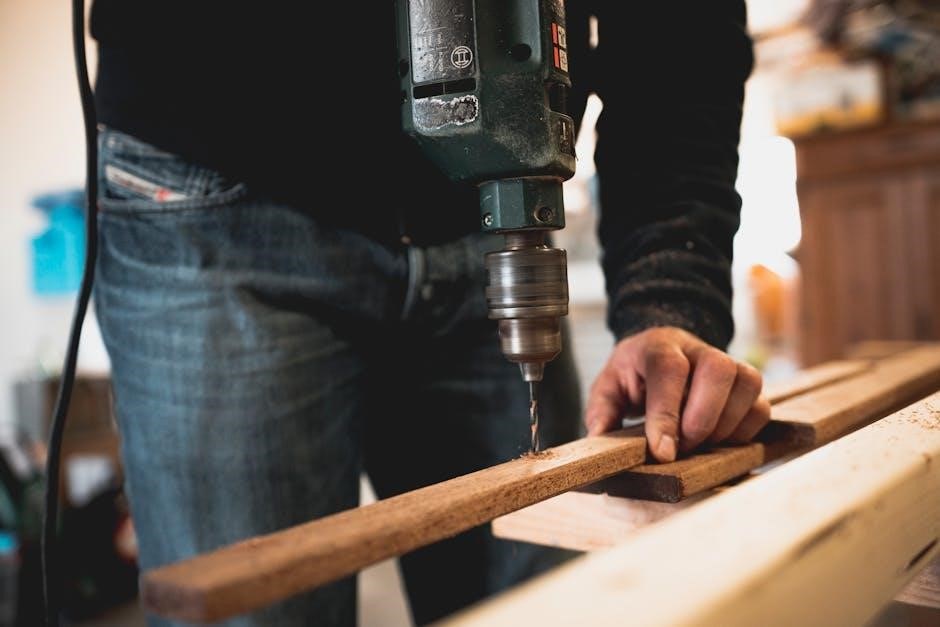wood framing details pdf
Wood Framing Details: A Comprehensive Guide
This comprehensive guide serves as your virtual wood frame construction manual, walking you through the process from foundational considerations to detailed assembly interface details; We’ll explore essential techniques and connections;
Wood frame construction stands as a time-tested method for building residential and light commercial structures. Its popularity stems from its cost-effectiveness, versatility, and the relative ease with which it can be adapted to various architectural designs. This method relies on a skeletal framework of wood members, primarily lumber, to provide structural support.
The beauty of wood framing lies in its adaptability. Designs can be easily modified on-site, and the material itself is renewable and readily available. Structures built with wood framing are known for their resilience when properly engineered and constructed, especially in regions prone to wind and seismic activity.

Understanding the fundamentals of wood frame construction is crucial for anyone involved in the building process, from architects and engineers to contractors and homeowners. A solid grasp of the techniques, materials, and connections involved ensures a durable, safe, and aesthetically pleasing final product. Throughout this guide, we’ll delve into the specifics, providing you with the knowledge needed to navigate the world of wood framing with confidence.

Key Components of Wood Framing
Wood framing relies on several key components, including lumber, sheathing, and connectors. Understanding each element is crucial for ensuring structural integrity and a durable building.
Wall Framing Details
Wall framing is a critical aspect of wood construction, involving the precise arrangement of studs, top plates, and bottom plates. These elements work together to create a strong and stable structure that supports the roof and provides a framework for exterior and interior finishes.
Understanding the spacing requirements for studs, typically 16 or 24 inches on center, is essential for load distribution and structural integrity. Proper nailing and connection techniques are also vital to ensure that the wall assembly can withstand wind, seismic, and gravity loads.
Shear wall panels, when integrated into the wall framing, enhance resistance to lateral forces, such as those generated by wind or earthquakes. The extension of wall framing and sheathing to the roof sheathing is crucial in transferring these loads effectively. Attention to detail in wall framing ensures a safe and durable structure.
Floor Framing Details
Floor framing provides the horizontal support system for a building, consisting of joists, beams, and subflooring. Joists are typically spaced 12, 16, or 24 inches on center, depending on the load requirements and span. Proper selection of lumber sizes and grades is crucial for ensuring adequate strength and stiffness.
Beams provide support for the joists, transferring loads to the foundation or supporting walls. Subflooring, typically plywood or oriented strand board (OSB), is attached to the joists to create a solid surface for flooring materials. Attention to detail in floor framing is essential for preventing squeaks and vibrations.
Adequate connections between joists, beams, and supporting walls are vital for transferring loads effectively. Proper installation of blocking or bridging between joists can enhance stability and prevent twisting. Under floor spaces should be ventilated.
Roof Framing Details

Roof framing is critical for protecting a structure from the elements, using rafters or trusses to support the roof sheathing and roofing materials. Rafters are typically spaced 12, 16, or 24 inches on center, with the spacing and size determined by load requirements and span. Roof trusses, often engineered wood trusses, offer efficient load distribution.
Proper connections between rafters or trusses and the supporting walls are essential for resisting wind and snow loads. Roof diaphragms must be connected to interior braced walls by drag trusses or truss blocking. Overhangs and eaves require careful detailing to prevent water damage.
Sheathing, usually plywood or OSB, is attached to the rafters or trusses to provide a nailing surface for the roofing material. Ventilation is crucial to prevent moisture buildup. When framed with engineered wood trusses, roof diaphragms shall be connected to interior braced walls by drag trusses or truss blocking.

Essential Wood Framing Connections
Secure and reliable connections are paramount in wood framing. These connections transfer loads effectively and ensure structural integrity, resisting forces from wind, seismic activity, and gravity, maintaining the building’s stability.
Wall-to-Foundation Connections

Wall-to-foundation connections are critical for transferring loads from the structure to the foundation. These connections resist uplift, shear, and overturning forces, ensuring the building remains anchored. Key components include anchor bolts embedded in the concrete foundation, sill plates, and sometimes, specialized metal connectors.
Anchor bolts, typically spaced at regular intervals, are embedded at least 7 inches into the concrete. Sill plates, usually made of pressure-treated lumber, are placed over the anchor bolts and secured with nuts and washers.
For two-pour foundations, specific details ensure a robust connection between the wall and foundation. These details often involve careful planning and precise execution to maintain structural integrity.
Proper detailing and execution of wall-to-foundation connections are crucial for resisting wind and seismic loads. These connections must be designed and installed according to local building codes and engineering specifications to ensure long-term stability and safety.
The American Wood Council (AWC) provides resources and guidelines for designing and constructing effective wall-to-foundation connections, as detailed in their wood frame construction manuals.
Wall-to-Roof Connections
Wall-to-roof connections are vital for transferring loads between the roof and wall systems, ensuring structural stability against wind uplift and lateral forces. These connections commonly involve rafters, trusses, top plates, and specialized metal connectors designed to resist tension and shear.
When engineered wood trusses are used, roof diaphragms must be securely connected to interior braced walls using drag trusses or truss blocking. This ensures that lateral loads are effectively transferred from the roof to the walls, enhancing the overall structural integrity.
Where interior walls act as shear wall panels, wall framing and sheathing should extend to the roof sheathing. This continuous connection provides enhanced resistance to lateral forces, particularly in areas prone to high winds or seismic activity.
Proper detailing of wall-to-roof connections is essential for meeting building code requirements and ensuring the safety and durability of the structure. The American Wood Council (AWC) provides guidelines and resources for designing and constructing effective wall-to-roof connections, as detailed in their wood frame construction manuals.
Accurate fabrication and competent engineering design are crucial for achieving reliable and robust wall-to-roof connections that can withstand various environmental loads.

Wood Frame Construction Manuals and Resources
Access comprehensive resources like the American Wood Council (AWC) publications and the “Wood Frame Construction Manual for One- and Two-Family Dwellings” for detailed guidance and best practices.
American Wood Council (AWC) Resources
The American Wood Council (AWC) provides a wealth of resources for wood frame construction. These resources include technical documents, design guides, and software tools that aid in the proper design and construction of wood-framed buildings. AWC’s publications cover a wide range of topics, from basic wood framing principles to advanced design techniques for wind and seismic resistance.
One of the key resources offered by AWC is the “National Design Specification (NDS) for Wood Construction,” which provides engineers and designers with the necessary information for calculating the strength and stability of wood members. AWC also publishes design guides that provide practical guidance on specific wood framing applications, such as wall, floor, and roof framing. These guides often include detailed illustrations and examples to help designers understand the principles involved.
Additionally, AWC offers software tools that simplify the design process and ensure compliance with building codes. These tools can be used to calculate load capacities, analyze structural performance, and generate construction documents.
Wood Frame Construction Manual for One- and Two-Family Dwellings
The “Wood Frame Construction Manual (WFCM) for One- and Two-Family Dwellings” is a comprehensive guide published by the American Forest & Paper Association (AF&PA). It provides prescriptive requirements for designing and building wood-framed homes, simplifying the process for builders and designers. This manual offers detailed information on various aspects of wood frame construction, including wall, floor, and roof framing.
The WFCM includes tables and guidelines for determining the appropriate size and spacing of wood framing members based on factors such as span, load, and species. It also covers connection details, such as nailing patterns and fastener requirements, to ensure structural integrity.
Furthermore, the manual addresses specific construction challenges and provides solutions for common problems encountered in wood frame construction. It is intended to be used in conjunction with competent engineering design and accurate fabrication, offering a valuable resource for ensuring the safety and durability of wood-framed homes. The WFCM serves as an essential tool for builders, designers, and code officials involved in residential construction.

Advanced Wood Framing Techniques
Explore engineered wood products and advanced framing methods, optimizing material usage and structural performance. Discover techniques enhancing energy efficiency and reducing construction waste in modern wood framing practices.
Engineered Wood Trusses
Engineered wood trusses represent a significant advancement in wood framing, offering superior strength and design flexibility compared to traditional framing methods. These trusses are meticulously designed using specialized software, ensuring optimal load distribution and efficient material usage. They are fabricated in controlled environments, guaranteeing consistent quality and precise dimensions.
The use of engineered wood trusses allows for longer spans and more open floor plans, eliminating the need for load-bearing walls in many cases. This design freedom enables architects and builders to create more spacious and aesthetically pleasing interiors. Furthermore, trusses are highly adaptable and can be customized to meet specific project requirements, accommodating complex roof shapes and unique architectural features.

When framed with engineered wood trusses, roof diaphragms need secure connections to interior braced walls, often achieved through drag trusses or truss blocking, as highlighted in construction manuals. Employing trusses enhances structural integrity and reduces on-site labor costs due to their ease of installation and pre-fabricated nature.

Considerations for Structural Design
Structural design requires careful attention to detail; Accurate load calculations and specifications are crucial. Wind and seismic load resistance must be prioritized for safety and compliance with building codes.
Wind and Seismic Load Resistance
Wood-frame structures must be designed to effectively resist wind and seismic loads. This involves careful consideration of wall framing and sheathing, ensuring continuous load paths from the roof to the foundation. Where interior walls act as shear wall panels, the framing and sheathing should extend to the roof sheathing to enhance stability. Correct detailing is important for the split-insulated wall assembly. The design example employs two-story plans as the basis for structural design against wind, seismic, and snow loads.
For roof diaphragms framed with engineered wood trusses, connections to interior braced walls should be achieved using drag trusses or truss blocking. Attention to detail in these connections is essential for transferring lateral loads. The American Wood Council (AWC) provides resources, including the “Wood Frame Construction Manual,” offering guidance on wind and seismic design considerations.
Load Calculations and Specifications
Accurate load calculations are paramount in wood frame construction to ensure structural integrity. Dead loads, including combined roof/ceiling or exterior walls, should not exceed 15 PSF, while floors or partitions should be limited to 10 PSF. The NDS equations are applied to specific structural elements. It is intended that this document be used in conjunction with competent engineering design, accurate fabrication, and adequate supervision of construction.
These calculations inform the selection of appropriate lumber sizes and connection details. Specifications should clearly detail the minimum concrete strength, embedment depth for anchor bolts, and any specific requirements for two-pour foundations. Understanding and adhering to these load calculations and specifications are crucial for safe and durable wood-framed structures. The American Forest & Paper Association (AF&PA) provides resources like the “Wood Frame Construction Manual” to aid in these calculations.
